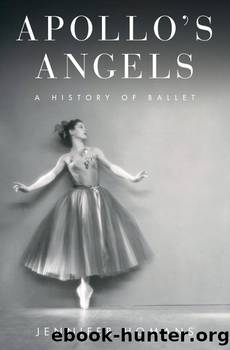Apollo's Angels by Jennifer Homans

Author:Jennifer Homans [Homans, Jennifer]
Language: eng
Format: epub
ISBN: 978-0-679-60390-0
Publisher: Random House Publishing Group
Published: 2010-03-14T16:00:00+00:00
Soviet ballet, it could be said, began in 1934. In that year Stalin contrived the murder of Sergei Kirov, first secretary of the Communist Party in Leningrad (and a personal friend), and then used his death to justify launching the Great Terror. In the course of the next four years, an estimated two million peopleâartists, intellectuals, and high Party officials prominent among themâwere arrested and sentenced to death or sent to labor camps. Leningrad, the countryâs cultural capital and Kirovâs personal fief, was crippled, and power was henceforth increasingly concentrated in Moscow. In a cynical and highly symbolic coup de grâce, however, Leningradâs State Academic Theater for Opera and Ballet (formerly the Maryinsky) was given the dubious honor of memorializing Kirovâs name. The Kirov Ballet was born.4
The Kirov, however, was not the countryâs only ballet company, nor even its most prominent. The Bolsheviks had always been suspicious of Leningrad (as St. Petersburg, former seat of the tsar, had been renamed) and under the press of the war they had moved the capital to Moscow in 1918, deliberately relocating the center of power to old Muscovite Russia. In the years after Kirovâs death, ballet followed suit, and the Bolshoi, which was situated close to the Kremlin at the geographic heart of Soviet political life, overtook its Leningrad cousin as the preeminent dance company of the USSR. This did not mean that the Kirov slipped into oblivion. As we have seen, the Kirov had always been the undisputed leader of the art, and it still boasted a better school, finer training, and a more elegant and refined style. And now, precisely because it had been politically demoted, it had a degree of artistic give that the Bolshoi would never haveâthe noose of ideology was not pulled quite as tightly there. The result was a tense but curiously productive relationship: through most of the Soviet period, the Kirov produced the countryâs greatest dances and dancers, but it was the Bolshoi that showcased them to the world. The flow of artists from Leningrad to Moscow was constant: it was the Kirov that provided the talent and ideas that made the Bolshoi Ballet the USSRâs premier cultural institution.
Several months before Kirovâs murder, Andrei Zhdanov, one of Stalinâs favorites recently promoted to the Central Committee, had addressed the First All-Union Congress of Soviet Writers. There he proclaimed the doctrine of socialist realism in art: âSocialist Realism ⦠demands of the artist the truthful, historically concrete representation of reality in its revolutionary development. Moreover, the truthfulness and historical concreteness of the artistic representation of reality must be linked with the task of ideological transformation and education of workers in the spirit of socialism.â If the language was stilted and obtuse, it nonetheless contained a simple and disarmingly contradictory imperative: make art that depicts gritty, ârealâ socialist themes (such as workers or collective farms) but give them an idealistic glow. Or, in the words of a popular song, âturn a fairy tale into realityââand reality into a fairy tale.
Download
This site does not store any files on its server. We only index and link to content provided by other sites. Please contact the content providers to delete copyright contents if any and email us, we'll remove relevant links or contents immediately.
| Ballet | Ballroom |
| Choreography | Classical |
| Folk | Jazz |
| Modern | Notation |
| Popular | Reference |
| Tango | Tap |
Call Me by Your Name by André Aciman(20349)
Ready Player One by Cline Ernest(14493)
How to Be a Bawse: A Guide to Conquering Life by Lilly Singh(7360)
Wiseguy by Nicholas Pileggi(5648)
The Kite Runner by Khaled Hosseini(5061)
On Writing A Memoir of the Craft by Stephen King(4847)
Audition by Ryu Murakami(4822)
The Crown by Robert Lacey(4710)
Call me by your name by Andre Aciman(4599)
Gerald's Game by Stephen King(4555)
Harry Potter and the Cursed Child: The Journey by Harry Potter Theatrical Productions(4427)
Dialogue by Robert McKee(4305)
The Perils of Being Moderately Famous by Soha Ali Khan(4156)
Dynamic Alignment Through Imagery by Eric Franklin(4099)
Apollo 8 by Jeffrey Kluger(3621)
Seriously... I'm Kidding by Ellen DeGeneres(3564)
The Inner Game of Tennis by W. Timothy Gallwey(3557)
How to be Champion: My Autobiography by Sarah Millican(3544)
Darker by E L James(3463)
